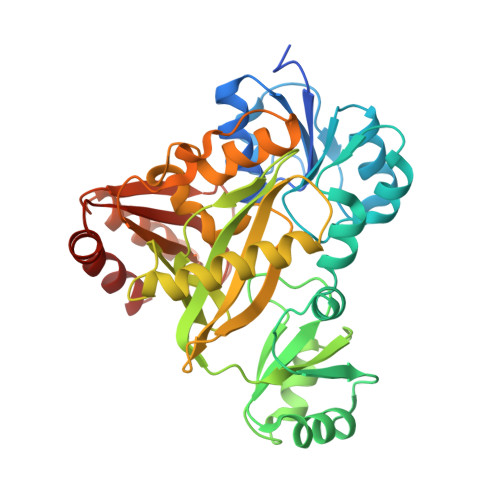Structural and functional studies of Aspergillus clavatus N(5)-carboxyaminoimidazole ribonucleotide synthetase
Thoden, J.B., Holden, H.M., Paritala, H., Firestine, S.M.(2010) Biochemistry 49: 752-760
- PubMed: 20050602
- DOI: https://doi.org/10.1021/bi901599u
- Primary Citation of Related Structures:
3K5H, 3K5I - PubMed Abstract:
N(5)-Carboxyaminoimidazole ribonucleotide synthetase (N(5)-CAIR synthetase), a key enzyme in microbial de novo purine biosynthesis, catalyzes the conversion of aminoimidazole ribonucleotide (AIR) to N(5)-CAIR. To date, this enzyme has been observed only in microorganisms, and thus, it represents an ideal target for antimicrobial drug development. Here we report the cloning, crystallization, and three-dimensional structural analysis of Aspergillus clavatus N(5)-CAIR synthetase solved in the presence of either Mg(2)ATP or MgADP and AIR. These structures, determined to 2.1 and 2.0 A, respectively, revealed that AIR binds in a pocket analogous to that observed for other ATP-grasp enzymes involved in purine metabolism. On the basis of these models, a site-directed mutagenesis study was subsequently conducted that focused on five amino acid residues located in the active site region of the enzyme. These investigations demonstrated that Asp 153 and Lys 353 play critical roles in catalysis without affecting substrate binding. All other mutations affected substrate binding and, in some instances, catalysis as well. Taken together, the structural and kinetic data presented here suggest a catalytic mechanism whereby Mg(2)ATP and bicarbonate first react to form the unstable intermediate carboxyphosphate. This intermediate subsequently decarboxylates to CO(2) and inorganic phosphate, and the amino group of AIR, through general base assistance by Asp 153, attacks CO(2) to form N(5)-CAIR.
- Department of Biochemistry, University of Wisconsin, Madison, Wisconsin 53706, USA.
Organizational Affiliation:





















